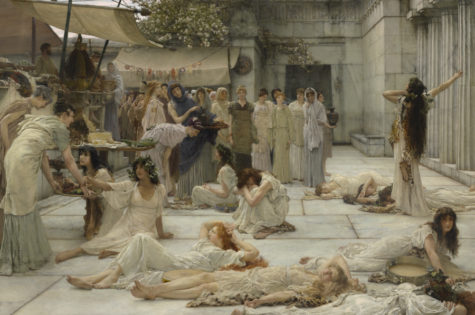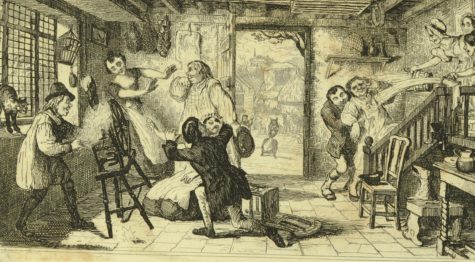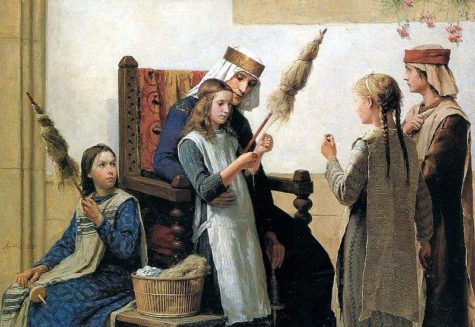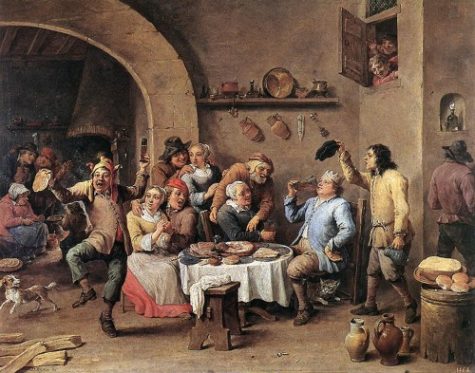Monthly Archives: January 2016
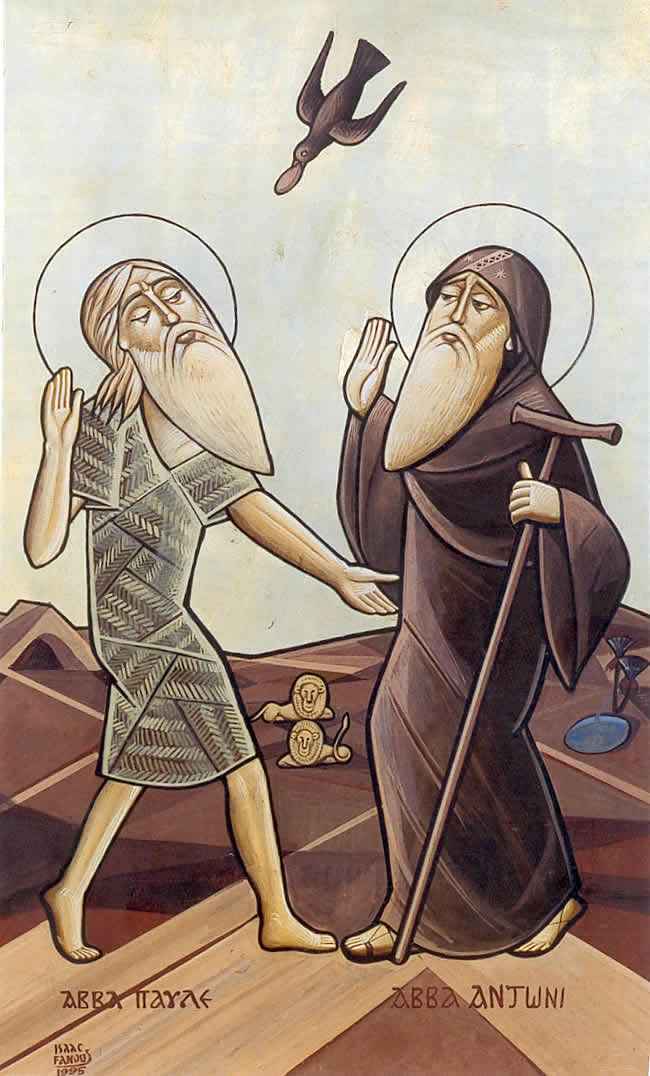 January 25 is St. Paul’s day, a festival of the Roman and English churches in commemoration of St. Paul. This day is thought to be prophetic as to the weather of the year:
January 25 is St. Paul’s day, a festival of the Roman and English churches in commemoration of St. Paul. This day is thought to be prophetic as to the weather of the year:
“If St. Paul’s day be fair and clear, It doth betide a happy year; If blustering winds do blow aloft. Then wars will trouble our realm full oft; And if it chance to snow or rain, Then will be dear all sorts of grain.”
In Germany when the day proved foul the common people used to drag the images of St. Paul and St. Urban in disgrace to duck them in the river.
- On the day of the conversion of St . Paul, (January 25th,) the four winds wrestle and the winner will blow most of the year. (Belgium.)
- If it rains on St. Paul’s day there will be plenty of mushrooms. (Bohemia.)
Other omens and folklore for St Paul’s day include the following:
- Fire will not burn a man born on St . Paul’s day, but if a woman who was born on that day is burned, the wound will never heal.
- Interestingly, in Sicily, it doesn’t matter what day you were born on – if you are a man fire will not burn you, but if you are a woman it will not only burn, it will eventually cause your death!
On a more positive note:
- If you set your hens to hatch on Paul’s day, they will become good layers.
Found in: Encyclopedia of superstitions, folklore, and the occult
January 25, the birthday of Scotland’s most famous poet, Robert Burns (1759-1796), has become an occasion for Scots all over the world to gather together in his honor. A Burns Night supper usually includes haggis, a traditional dish of the heart, lungs, and liver of a sheep or calf minced with suet, onions, oatmeal, and seasonings. Burns’s words: “Hail Great Chieftan o’ the Puddin-race!” greets the dish’s entry into the room. Men wear kilts and women their tartan sashes, and the evening’s celebration includes reading Burns’s poems and singing his songs, ending with one of his most famous, “Auld Lang Syne.
Found at Almanac.com
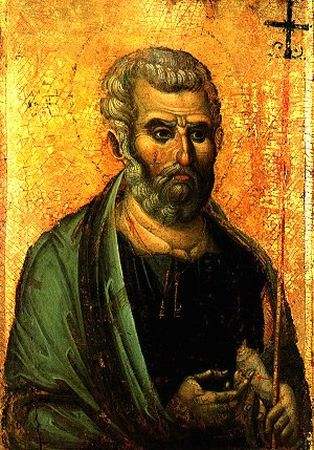 There are two feast days in the year which are dedicated to St Peter. January 16, and June 29 (which is the feast of Saints Peter and Paul). What follows is lore and superstition surrounding St Peter’s day:
There are two feast days in the year which are dedicated to St Peter. January 16, and June 29 (which is the feast of Saints Peter and Paul). What follows is lore and superstition surrounding St Peter’s day:
- No building should ever be begun on St . Peter’s day. It will never prosper.
- The Wallachians say that on St. Peter’s day all roads are guarded by serpents, and whoever kills one on that day will be lucky all the year.
- If it rains on St. Peter and St. Paul, there will be plenty of mushrooms.
- If you set your hens to hatch on Peter’s and Paul’s day, they will become good layers.
- Make nests for the hens on St . Peter’s day, And many ‘s the egg that they will lay.
Collected from various sources
 In Sweden, January 13, St Knut’s Day, is the traditional day to discard the Christmas tree and end the season’s festivities. A children’s party is the favored way to strip the tree of its decorations, after which the children are free to “plunder” the edible treats and small gifts placed on the tree especially for the occasion.
In Sweden, January 13, St Knut’s Day, is the traditional day to discard the Christmas tree and end the season’s festivities. A children’s party is the favored way to strip the tree of its decorations, after which the children are free to “plunder” the edible treats and small gifts placed on the tree especially for the occasion.
This Christmas tree plundering is often accompanied by smashing up the gingerbread houses and eating them while discarding of the decorations. Finally, everyone “dances” the tree out the door. Singing special songs, they pick up the tree and toss it out into the snow.
However in Finland, the tradition is quite different:
Called Nuutinpäivä, there has been a tradition somewhat analogous to modern Santa Claus, where young men dressed as a goat (Finnish: Nuuttipukki) would visit houses. Usually the dress was an inverted fur jacket, a leather or birch bark mask, and horns. Unlike Santa Claus, Nuuttipukki was a scary character.
The men dressed as Nuuttipukki wandered from house to house, came in, and typically demanded food from the household and especially leftover alcoholic beverages. In Finland the Nuuttipukki tradition is still living at areas of Satakunta, Southwest Finland and Ostrobothnia. However, nowadays the character is usually played by children and now involves a happy encounter.
A proverb from Noormarkku says:
Hyvä Tuomas joulun tua,
paha Knuuti poijes viä
“Good Thomas brings Christmas,
evil Knut takes it away.”
Courtesy of: almanac.com and Wikipedia
 Tonight is the night of the Wolf Moon. This first full moon of the new year is a time of silence and sitting by the home fire. As the wild winter howls, appreciate the warmth of home and family.
Tonight is the night of the Wolf Moon. This first full moon of the new year is a time of silence and sitting by the home fire. As the wild winter howls, appreciate the warmth of home and family.
Now is the time to go within and plan the changes you will make in the spring. Consider now what you will plant. Start a moon journal to record your lunar tides and write down your spring dreams.
Correspondences:
- Colors: Black and white, silver
- Gemstones: Hematite
- Trees: Birch, Hazel
- Gods: Inanna, Freyja
- Herbs: Thistle, nuts and seeds, marjoram
- Element: Air
Full Moon names started with Native Americans as tribes kept track of the seasons by giving distinctive names to each recurring full Moon. The names actually applied to the entire month in which each occurred. There was some variation in the names based on tribes. European settlers followed that custom and created some of their own names.
Sometimes it is also referred to as the Cold Moon, Old Moon, or the Moon After Yule. Some called it the Full Snow Moon, but Wolf Moon seems most appropriate, in native cultures, because amid the cold and deep snows of midwinter, the wolf packs howled hungrily outside their small villages, huts, and teepees. Since the lunar month is only 29 days long on the average, the full Moon dates shift from year to year.
This is a good time to work on magic related to protection, both physical and spiritual. Use this time to develop your inner self, and advance spiritually, becoming closer to the higher aspects of your deities.
More about the Full Wolf Moon
It’s been a tough month for some of us. I thought it fitting to toss out some symbolic observations about the January Wolf Moon with a goal to offer inspiration to folks facing some challenges right now.
- Lunar Symbolism:
Before blasting off into Wolf Moon symbolism, let’s take a look at lunar implications. Subtle, cunning and soft in silky shadows, the moons meanings can be slippery. But, to those who grasp moon symbolism, great insights follow. Typically feminine in archetypal understanding, the moon carries themes of cycles and fertility.
Moreover, the moon conveys a kind of creativity that is born from veiled magic. Consider the moon’s growth cycles (waxing, full, waning, new). These phases are wrought from the moon’s movement. And, the manifestation of her development is made known to us through light and shadow.
What’s the symbolic lesson here? Progress is sometimes subtle. Manifestations of evolution often occur behind the scenes, in shadow – before we “see the light” or the end-product of our vision.
When contemplating this month’s full moon and its partnership with the Wolf, we must not cram our intellect into the void. Rather, the Wolf Moon asks us to use intuitive instinct in soft ways.
The gifts of this full moon come to our senses like steam rising over sacred waters marbled with frosty stillness.
Wolf Symbolism and Wolf Moon Solutions:
Strategic, resourceful and incredibly communicative, the Wolf is a noble mentor for humankind. Wolves have specific protocol and rank within their packs. This observation is a cue to look to community for creative solutions during this full moon. Communicate with those in your pack to help you with your challenges. But don’t break taboo. If you follow specific traditions in social communication, hold to them. In fact, use this full moon to honor traditions of your heritage. Take time to honor your elders too. Tribal rituals should be heeded this time of year.
Wolves are vastly expressive. Sure, their vocalizations (baling, howling and barking) are legendary, but Wolves also have an complex system of body language and even eye contact to convey intent and current state of being. Discipline in the pack is rarely corporeal. Rather, behavior is admonished or reinforced by intricate expressions. One look from the Alpha can convey as much power as a physical blow.
There’s big medicine in this. Use this full moon to get in touch with your own modes of expression. Explore your own eye contact and body language. Examine yourself in the mirror (yes, I’m serious) as you’re talking on the phone. View yourself objectively. What are your expressions conveying? How can you modify or enhance your body language to portray more authority or power? Or, perhaps more softness and sensuality is needed. Too often we are unconscious about our eye and body movements in the scheme of social interaction. This is a great time to ponder these nuances of communication.
Wolves are also phenomenally resourceful. In fact, their resourcefulness is partly why this moon carries the Wolf moniker. January is a brutal month in the northern regions. The frigidity of winter crunches life to a stand-still in the wild. To be sure, it’s a time of “sink or swim” to all wildlife exposed to the elements this time of year.
Wolves, however, often thrive during this lean month. They are designed to handle the brutality of cold quite well. Furthermore, as Wolves are inclined to pick off weaker animals, January offers up a host of feasting options. Perhaps we can use the resourcefulness of the Wolf to reconsider our options in life. Maybe what seems bleak or lame in our life is actually an invitation for opportunity. Food for thought.
I hope these symbolic ideas about the cold Wolf Moon inspire you to take advantage of January’s lunar fullness. Take a pause on the evening of this month’s full moon to contemplate your own inner wisdom too. I bet your findings will be illuminating.
~collected from various sources, including Symbolic Meanings
At dusk on January 8th, the Haloa (῾Αλῶα) starts. Haloa took place every year, during the month Poseideon (Ποσειδέωνας), after the first harvest was over. The festival took place around the threshing floor (αλώνια) at the same time throughout Attica. At Eleusis there was a festival called Haloea on the 26th of the month Poseideon.
All women were expected to attend this event, but men were almost always excluded. Interestingly enough, men had a legal and moral expectation to pay for their wives’ expenses in these festivities. The strange timing of the harvest festival—mid-winter—is significant as well.
The Haloea, a festival for Demeter and Dionysus, included a procession for Poseidon. The Haloea is thought to have been a time for merriment. There is mention of a women’s rite in connection with this holiday: Women are provided with wine and food, including cakes in the shapes of sexual organs. They withdraw to themselves and “exchange scurrilous banter, and are teased with suggestions of promiscuity whispered in their ears by ‘the priestesses’.” The women are thought to have stayed secluded throughout the night and then to have joined the men the next day. While the women were off eating, drinking, and sounding much like the women of Lysistrata, the men are thought to have created a big pyre or a bunch of little bonfires.
The Greeks regarded the festival as sacred to not only Demeter but also to Dionysus. With the inclusion of Dionysus in the festival worship, the date shifted towards the winter as “he possessed himself of the festivals of Demeter, took over her threshing-floor and compelled the anomaly of a winter threshing festival.” In many ways, the festival was just as connected, if not more so, with Dionysus than with Demeter. Thus, we see the power and influence of the incoming god and of the importance of wine to Greek cult activity. Practically, Greeks were able to coax out a harvest just early enough to revel with Dionysus.
Despite being among the most documented of Greek festivals, very few records of what exactly occurred during Haloa. Because it was a predominantly, if not exclusively, women’s festival, little information has survived, or was recorded at all, about its characteristics and rituals. In fact, one of the most detailed sources of Haloa actually consists of marginal notes from the 13th century AD on the Roman writer Lucian’s works.
According to these notes, the women’s ritual practices involved “pits, snakes, pigs, and models of genitalia, all of which have a more or less marked sexual significance.” We also know that the festival “is said to have comprised Mysteries of Demeter, Kore, and Dionysus.” Another source singled out these women’s festivals as “containing the germ of ‘Mysteries,’” referencing here the Eleusinian Mysteries—annual initiation ceremonies devoted to the cult of Demeter and Persephone.
Celebrating Haloa
In the earliest times the religious part of the festival might have been restricted to married women, but after the fourth century BCE its celebration may have been limited to hetairai (ἑταῖραι, female companions, a term used non-sexually for women, about women, but used by men to indicate a woman hired for entertainment, often leading to sex), or they were simply also allowed to hold their own symposium during the Haloa, either at home or at Eleusis. The Haloa would have been the day on which they were initiated into the Mysteries. The Eleusinian Arkhontes (Ἄρχοντες, male magistrates of the Mysteries) prepared a huge banquet on this day, with a huge variety, including phallus- and vagina-shaped cakes, but not foods forbidden in the Mysteries: pomegranates, apples, eggs, fowls, some types of fish were out. Animal sacrifice was also disallowed on this day: Demeter received offerings of fresh fruit.
After preparing the food, the Arkhontes left, leaving the women to eat, to drink lots and lots of wine, and to celebrate being a woman and fertile (or the wish to be fertile). The Arkhontes went to the men who were waiting outside of Eleusis for their part in the Mysteries, and told them the story of Eleusis, and how the Eleusinians had discovered nourishment for the entire human race. A giant phallus is often assumed to have been set up on the hálōs, and the women would dance around it carrying clay models of phalli and vaginas, but it is more likely the phallus was never there, but depicted on art work about the Haloa to indicate the fertility aspects of the festival and the dances that occurred there. As part of the festivities, the women engaged in sexualized conversation with each other. As part of the sacrifice, the women carried kernoi (κέρνοι, offering dishes) on their heads, containing incense, grains or other offerings, which they tipped onto the giant phallus or, and this is probably far more accurate, onto the altar.
After the feast and sacrifice, the men who had been waiting were admitted to the grounds, and the women were encouraged by each other–including the priestesses–to take secret lovers for the night. A priest and priestess–with torches representing Demeter and Persephone–apparently sat watch on chests as they presided over the fertility celebration.
To Do Today:
The Haloa is the perfect time to organize an adult ‘girl’s night’ with your closest female friends. Watch a movie with erotic tones, drink wine together, gorge yourselves on chocolate and gossip about your partners. If you have an agreement about it with your partner, you could find a lover for the night. If not, go home to him or her and spend the night together in your own ‘fertility rite’. If you’re single and have no one to fill your bed… well… a girl can get creative, can’t she?
For the men, the Haloa might have had an extra ritual part as well; honoring Poseidon as an agricultural Theos. There is evidence that the men built a huge bonfire and had their own conversations around it. Afterwards, they joined the women, when possible (and desired). Single men; I’m sure you can be as creative as the single women reading this.
It’s Distaff’s Day (Jan 7th) and time to get back to work after the holidays. (According to Old English tradition, that is.) A distaff is the wooden rod (staff) that holds the flax or wool on a spinning wheel. The term distaff came to refer to both women’s work and the female branch (distaff side) of the family. The women’s husbands did not go back to work until the following Monday (see below), so they would mischievously try to set fire to the flax on their wives’ distaffs, while the women, lying in wait, would douse them with buckets of water.
From Chambers Book of Days, we have this explanation:
As the first free day after the twelve by which Christmas was formerly celebrated, the 7th of January was a notable one among our ancestors. They jocularly called it St. Distaff’s Dag, or Rock Dag, because by women the rock or distaff was then resumed, or proposed to be so. The duty seems to have been considered a dubious one, and when it was complied with, the ploughmen, who on their part scarcely felt called upon on this day to resume work, made it their sport to set the flax a-burning; in requital of which prank, the maids soused the men from the water-pails.
“Partly work and partly play.
Ye must on Saint Distaff’s day;
From the plough soon free the team,
Then come home and fother them;
If the maid a spinning goe,
Burn the flax and fire the towe,
Bring in pails of water then
Let the maids bewash the menne;
Give Saint Distaff all the right
Then bid Christmas sports good-night,
And next morrow every one.
To his own vocation.”
This is an excellent day for spells involving sewing, weaving, mending, and also for practical jokes and family fun.
A Ritual for St Distaff Day:
From the book, 365 Goddess, we have some nice ideas for how to celebrate St. Distaff day in a magickal way:
- Themes: Work, Weaving, Destiny
- Symbols: Web, Spinning Wheel, Needle
Presiding Goddess:
Arachne, the Greek spider goddess, inspires positive changes in your destiny for the new year. Legend tells us that Arachne challenged Athena to a weaving contest and won. In anger, Athena destroyed the girl’s tapestry. Arachne, grief-stricken, took her destiny in hand and turned herself into a spider, but she continues to use her weaving talents to spin and pattern the lives of mortals.
To do today:
According to lore, Saint Distaff, the patroness of weaving, was a fictional persona made up to mark the resumption of normal activity after the holidays. Instead of this imaginary figure, we turn to Arachne to help us take the strands of our fate in hand and begin weaving a year filled with goddess energy.
To direct your spiritual focus toward the goddess, wear something woven today, or display it proudly. If you have no such items, braid together three strands of thread or yarn, saying:
Arachne, bless this magic braid,
so on you my mind is staid.
Carry this as a charm to keep your thoughts and actions goddess-centered.
Finally, mend any work clothes in need or repairs to improve your job standing. As you make the final knot in a button or hem, bind the magic by saying:
This thread I wind,
The magic bind.
Visualize your professional goals as you work.
More about St. Distaff Day:
St. Distaff’s Day had no connection whatsoever with any saint but its place in the folk calendar gives an indicator of the importance of spinning at a time when this was the only means of turning the raw wool, cotton or flax into thread capable of being woven into cloth.
The day, which was also known as Rock Day (referring to another name for either the distaff or the spindle) indicated that this was the end of the Christmas festivities and the return to the normality of spinning whenever there was a spare moment.
As Anthony Fitzherbert, wrote in his ‘Boke of Husbandrie’ (1523):
it saveth a woman from being idle,
and the product was needful’.
Before the invention of the Spinning Wheel, spinning on what is known as the Drop Spindle (a pin or stick weighted by a whorl) was a slow and tedious task. The spinning of one pound of woolen yarn could take about one week and one pound of heavy cotton yarn several weeks to spin.
The method had not changed since the earliest times. There are images from as far back as time of the Ancient Egyptians showing how the distaff was used to hang the flax or tow and the spindle to effect the twisting. The distaff was carried under the arm, and the spindle left dangling and turning in the fingers below, and forming an axis round which to wind parcels of the thread as soon as it was made.
Women of all classes would spin. Everyone from the Lady to the peasant was expected to spend time on the task, though the wealthier may have elaborate spindles. In the evening, after the chores of the day were done, there would be spinning, and the spindle would be taken to visit friends as the task could be undertaken at the same time as a conversation.
Source: Telling History
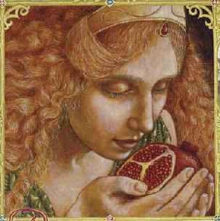 Themes: Luck, Cycles, Youthful Energy
Themes: Luck, Cycles, Youthful Energy
Symbols: Coins, Corn, the number 7, Flower Buds, Pomegranate
About Kore: An aspect of Persephone before her marriage to Hades, this youthful goddess motivates good fortune, zeal, and a closer affinity to earth’s cycles during the coming months.
Kore, whose name means “maiden,” is the youngest aspect of the triple goddess. She was the daughter of Zeus and Demeter, as beautiful as spring’s blossoms and as fragrant as its breezes. It was this beauty that inspired Hades to tempt her with a pomegranate, a symbol of eternal marriage. Because she ate the fruit, Persephone spends winter with Hades as his wife and returns to the earth in spring.
To Do Today (Jan 5 or 6): Traditionally, on this day the Greeks carried an image of Kore around the temple seven times for victory, protection, and good fortune. Since your home is your sacred space, consider walking clockwise around it seven times with any goddess symbol you have (a round stone, vase, or bowl will suffice). As you go, visualize every nook and cranny being filled with the yellow-white light of dawn, neatly chasing away any lingering winter blues.
This day marks winter’s passage and perpetuates Kore’s gusto and luck in your home year-round. Also consider carrying a little unpopped popcorn in your pocket to keep Kore’s zeal and vigor close by for when you need it.
Other Rites of Kore: Epiphanius (fourth century), gives an account of a rite held at Alexandria on the night of January 5-6.
In the temple of Kore – the Maiden (Persephone) – he tells us, worshipers spent the night in singing and flute-playing, and at cockcrow brought up from a subterranean sanctuary a wooden image seated naked on a litter. It had the sign of the cross upon in gold in five places – the forehead, the hands, and the knees. This image was carried seven times round the central hall of the temple with flute-playing, drumming, and hymns. It was said: “To-day, at this hour, hath Kore (the Maiden) borne the Aeon.” The image was then taken back to the underground chamber.
Courtesy of: 365 Goddess and other sources
In Old England, The Twelfth Night marked the end of the winter festival that started on Samhain. The Lord of Misrule symbolizes the world turning upside down with the coming of winter. In the middle ages, the Twelfth Night began on the eve of December 25th moving forward 12 days to January 6th, hence the name the twelve days of Christmas.
The Twelfth Night festival marked the onset of the winter solstice, the point in late December when the sun, whose daily arc had reached its lowest, darkest, coldest point, began its rise toward the longer, warmer days and the coming of spring. On December 25th, the ceremonial Yule log was hauled in to start the hearth fire around which its members and visitors would gather throughout the rest of the Christmas festival days.
Twelfth Night was the final frenzy of feasting, drinking and merry making before the townspeople returned to daily life for the remainder of winter. A grand cake was the focus of the celebratory feast as well as Wassail, Fig Pudding and other generous tasty handmade dishes.
In the ancient times of the Roman Saturnalia, the “king of the feast” was elected by beans, and the Twelfth Night cakes included a bean–or, later, a ring or coin. Whoever was given the slice with the prize became the queen and king for the night and much parading and merriment followed.
In the church calendar, Twelfth Night is the evening before Epiphany (January 6). Because the three wise men (or kings) arrived in Bethlehem bearing gifts for the infant Jesus, Epiphany is also called Three Kings Day and a traditional time of gift giving.
Sources: White Magick Alchemy and Almanac.com
The eleventh day of Christmas (Jan 4th) is Evergreen Day. An evergreen tree is a tree that has leaves in all seasons. This contrasts with deciduous trees which completely lose their foliage during the winter or dry season.
The term “evergreen” can refer metaphorically to something that is continuously renewed or is self-renewing. One example of metaphorical use of the expression is the term “Evergreen content” used to describe perennial articles or guides about topics that do not change frequently.
On the Internet, evergreen is a term used by some ad agencies to describe a Web site that is updated on a daily or other frequent basis. A Web site that is evergreen is considered more likely to attract both first-time and repeat visitors.
In magick, evergreens are considered to have a cleansing, and revitalizing power. The aroma of evergreen trees reinvigorates and replenishes psychic and magical energy.


